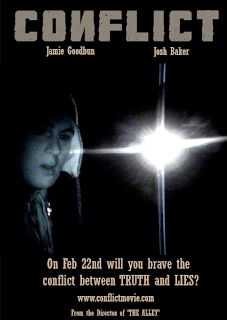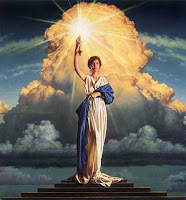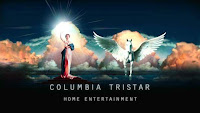Task 7.2 Evaluation - Personal
Task 7.1 Evaluation - Initial Presentation To Class
Task 6.2 Ancillary Task - Film Poster

1.
 2.
2. - Clear title
- Recognisable image or figure from the film
- Significant Date
- Website address
- Inter-textuality
Task 6.1 Ancillary Task - Film Magazine Cover
- Distinctive image
- Clear message
- Suitable use of fonts and colours
- Bar code
- Price
- Issue Number
- Website
Task 4.5 (Planning - Preparation)
 In this shot we have tried to assist the audience in identifying with the location more than the actual actors, which is why the tree is featured in the fore-front of this image.
In this shot we have tried to assist the audience in identifying with the location more than the actual actors, which is why the tree is featured in the fore-front of this image. Task 4.4 (Planning - Script/Outline)
Task 4.3 (Planning - Photo Animatic)
Task 4.1 (Planning - Storyboard)
Task 3.2 (Pitch - Presentation)
- Which brief we have chosen and why
- Choice of genre and why
- The basic story line
- Next stage of planning to be carried out
- Lessons to be learnt - objectives
- Experiences
Task 3.1 (Pitch - Initial Ideas)
- We are both interested in films and regularly watch them, so we are able to see lots of trailers in many formats, on the internet, in cinemas and at the start of DVDs.
- We feel as though a better outcome would be possible from producing a teaser trailer than a music video because, we wouldn't need to contact an unsigned artist after searching high and low for a band which suits both of our musical interests/preferred genre.
- We also have experience of film making during the AS part of the course, when we produced "The Alley". We will be able to develop our skills even further into making the trailer as we have chosen to do a Thriller trailer, as we did for the AS course.
- Ideas - choosing genre, storyline, characters etc..
- Anematics - Storyboards (both drawn and photographed)
- Synopsis of the whole film to make it easier for us to piece the film together and help to make the trailer make sense. (Basic storyline)
- Script of the trailer (not the whole film)
Task 2.1 (Production Company Background)
Therefore the logo's of these companies are normally significantly noticeable at the start or end of a production. As the film industry develops, so do the logo's of production companies.
Columbia Pictrues was founded in 1920 by Jack and Harry Cohn and Joe Brandt. They were bought out by Sony in 1989, at the time it was a growing trend for Japanese companies to buy American firms.
Before the purchase their logo was:

After the purchase, Sony re-named the company "Columbia Tri-Star" and a new logo was developed to reflect this:

Walt Disney Pictures, the film banner, was established as a designation in 1983, prior to which Disney films since 1954 were released under the name of the parent company, then named Walt Disney Productions.
Their logo has always been a simple Castle on a blue background, with Walt Disney's signature as the font for the name:

As you can see from the picture below, the logo for Walt Disney has now developed into a much more graphical design.

Task 1.1 (Research - Initial Trailer/Short Film Analysis)
Change of Plan!
Task 5 - (Research - Michael Jackson's 'Scream')
Task 4 (Research - Music Promo Research)
Task 3 (Research - The Growth of Music Videos)
1940 - Soundies
The 'soundies' are an early form of music video. Produced in New York, Chicago and Hollywood these films were three minutes long and normally consisted of short dance sequences.
These early version music videos were shown on coin-operated jukeboxes in clubs and restaurants.
'Soundies' covered all genres of music although they were especially popular for playing a part in the spread of African-American artists who found it difficult to publicise their work on other public mediums.
Here is an example of a 'Soundies'music video;
"Zig Me Baby with a Gentle Zag (Featuring Gai Moran and Danny Hocktor"
--------------------------------------------------------------------------
1961 - Ricky Nelson
During 1961, Ricky Nelson's "Travelin Man" video is shown on television. The short film made to promote the video is considered the first music video.
--------------------------------------------------------------------------
1962 - New form of music video for television
In 1962 television production companies invented a new form of music television. They created programs such as "Top Of The Pops", "Ready! Steady! Go!" and "Oh, Boy".
These programs allowed artists to come on and promote themselves. The shows started as band vehicles but soon became a huge hit across the country.
--------------------------------------------------------------------------
1970 - Great Opportunity
The record industry discovered that the aforementioned TV shows provided them with a great opportunity to get artists noticed. The record industry began to produce many short "Promos" which could be featured on television instead of some live performances.
--------------------------------------------------------------------------
Task 2 (Research - Genre Comparative Study)
T.I - Live Your Life ft. Rihanna
Flo Rida - Sugar Ft. Wynter Gordon
Task 1 (Research - Initial Six Stage Analysis)
Lady Gaga - Paparazzi
This music video takes up some of the conventions for pop videos and the main one being the sex appeal of the lead singer. This comes across strongly throughout the video.
There is a clear link between lyrics and the visuals being presented to the audience. The main message being presented is the role the “paparazzi” play in the world so there are a number of insert shots of newspaper articles and there is even some camera views through a photographers camera lens.
The music also has a distinctive link to the visuals. At first there is an unusual opening to the song in that there is no music to go with the visuals to begin with, instead this silence and only dialogue allows the dialogue and visuals to be enhanced. There is also an idea that the beat of the music that starts off a rhythm if you like for some of the camera cuts.
Lady GaGa is featured throughout the music video and this helps with the main job of promoting herself and her new song. The video also helps her to create the image she wants to be perceived by the audience. There is a slight twist within this music video, in that the video is actually a story of how Lady Gaga maybe doesn't want to be promoted.
I think that the artist has deliberately used a large amount of voyeurism for the audience; her sex appeal will attract a larger audience than most moderate music videos. There is also voyeurism within the music video, where the paparazzi are smothering her with their cameras once she fell of the balcony.
















